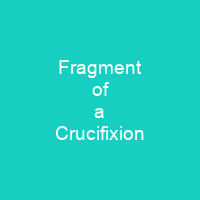Fragment of a Crucifixion: A Glimpse into Francis Bacon’s Existential Struggle
Imagine a painting that captures the essence of an existential struggle, where two creatures are locked in a fierce battle over a chimera. This is precisely what Fragment of a Crucifixion, an unfinished 1950 masterpiece by Francis Bacon, portrays.
The Central Drama: A Dog or Cat vs. the Chimera
In this painting, the upper figure, possibly a dog or cat, crouches over the chimera and prepares to deliver the fatal blow. Meanwhile, the lower figure struggles against its fate, positioned on a T-shaped cross that might symbolize Christ’s crucifixion.
Passer-by Figures: The Opaque World
But what about those thin-sketch passer-by figures surrounding the central drama? They seem oblivious to the action unfolding before them, much like how we often ignore the struggles of others in our daily lives.
The Title and Its Religious Connotations
The title Fragment of a Crucifixion draws from religious iconography but Bacon himself did not believe in divine intervention or an afterlife. The chimera’s despair serves as the centrepiece, representing a bleak view of the human condition.
Bacon’s Personal Outlook and Artistic Style
Bacon’s personal outlook was bleak, viewing his work as a representation of nihilism and hopelessness. The upper creature is shown in a mixture of white and black hues, with blood pouring from its mouth onto the chimera’s body. The lower figure is positioned on a T-shaped cross, which may signify Christ’s crucifixion.
The Painting’s Home and Influences
This painting can be found in the Stedelijk Van Abbemuseum in Eindhoven, Netherlands. It features pentimenti used by Bacon to emphasize the hopelessness of the animal’s death throes. The work contains similar elements found in Bacon’s earlier works, including angular shapes and a focus on the figure’s mouth and facial expressions.
Existentialism and Nihilism
Bacon’s harsh nihilism and existentialist view of life developed after he stopped believing in Christianity. The screaming mouths that appear in many of his works from the late 1940s to the early 1950s, including this one, were inspired by medical textbooks and images of the nurse in Sergei Eisenstein’s film Battleship Potemkin.
Influences and Series
Bacon drew inspiration from old masters such as Grünewald, Velázquez, Rembrandt, and Picasso’s biomorphs. He referred to the Odessa nurse in paintings throughout his career. The panel is one of a number of Bacon’s treatments of the biblical crucifixion scene, influenced by Greek legend and Christian iconography.
Commissioned by Eric Hall
Bacon was commissioned by Eric Hall, his patron and lover, to create three crucifixion paintings in 1933. The elements of the canvas refer to Grünewald’s Isenheim Altarpiece and Rubens’ Descent from the Cross, showcasing Bacon’s influences and artistic development.
Self-Criticism and Destruction
Bacon was self-critical and destroyed some pieces, including Fragment of a Crucifixion, due to its simplicity and explicitness. He returned to the crucifixion theme in his 1962 work Three Studies for a Crucifixion, this time using more oblique imagery.
Through Fragment of a Crucifixion, Bacon invites us to confront the raw, unfiltered reality of human existence. His work serves as a stark reminder that in our lives, we often find ourselves engaged in struggles that are both personal and universal. As we navigate these challenges, it is essential to remember that every moment holds its own form of beauty and truth.
You want to know more about Fragment of a Crucifixion?
This page is based on the article Fragment of a Crucifixion published in Wikipedia (retrieved on November 29, 2024) and was automatically summarized using artificial intelligence.








